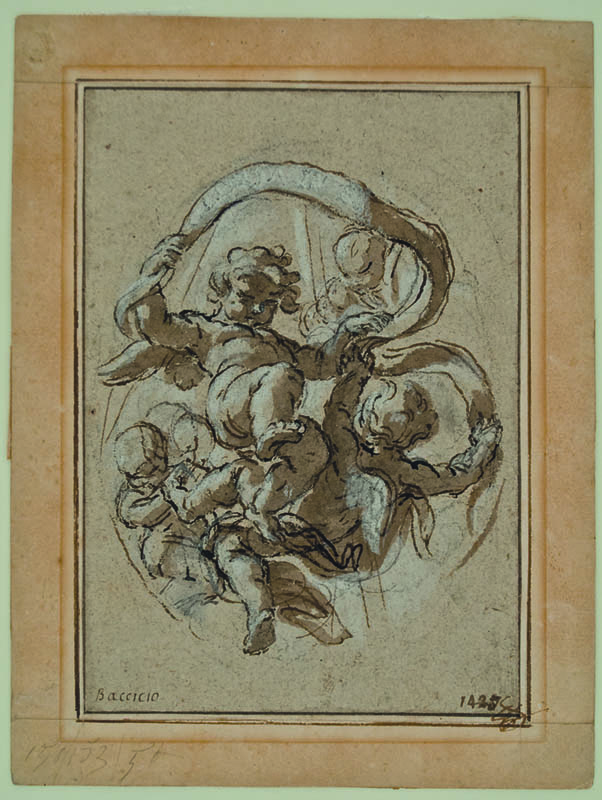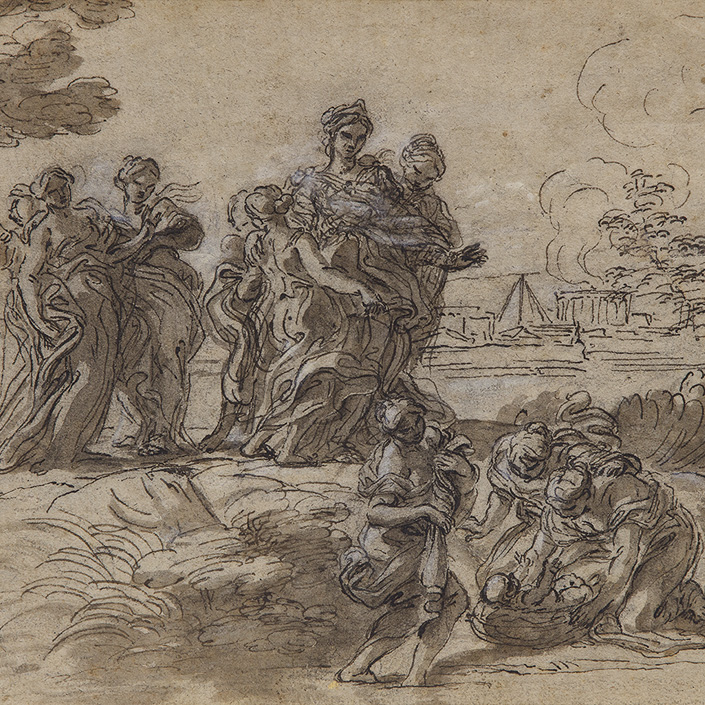Giovanni Battista Gaulli called Baciccio
Genova 1639 - Roma 1709
Gloria in ex (celsis deo)
181 x 128 mm
inscription in lower left: ‘Baciccio’
‘It is obviously a study for a vault or a small cupola of a chapel, as shown by it’s insertion in an oval and the inscription on a cartouche saying ‘Gloria in Ex (celsis Deo)’, the angels’ hymn to announce the birth of Christ. It could also be a study for the small cupola in the sacristy of the Montioni chapel in S. Maria in Montesanto, Rome, also oval in shape, with angels and Christological symbols in the gores although the final design for the small cupola represents the Holy Ghost surrounded by cherubs (F. Petrucci, Baciccio, Giovanni Battista Gaulli 1639-1709’, Roma, 2009, cat. B30, pp. 504-505).
A similar putto to that in the center of our composition can be found in Düsseldorf, Kunstmuseum (Giovan Battista Gaulli Il Baciccio 1639-1709, exhibition catalogue, Ariccia, Palazzo Chigi, Milano 1999, fig. a p. 326). Another study for a cherub with cartouche, in the Kunstmuseum Düsseldorf (Inv. n. FP 10613. Dieter Graf, 1976, Die Handzeichnungen von Guglielmo Cortese und Giovanni Battista Gaulli, foto 664 n. 518).’
We would like to thank Prof. Francesco Petrucci, Conservator of Palazzo Chigi in Ariccia, for his generous contribution in the cataloguing of this drawing.
References:
Engass: ‘ The painting of Baciccio, ‘Giovanni Battista Gaulli 1639-1709’, 1964.
Dieter Graf: ‘Die Handzeichnungen von Guglielmo Cortese und Giovanni Battista Gaulli’, 1976; 2 vol.
M.F.Dell’Arco, D.Graf, F.Petrucci: ‘Giovan Battista Gaulli Il Baciccio 1639-1709’, catalogo della mostra, Ariccia, Palazzo Chigi, Milano 1999.
F.Petrucci: ‘Baciccio, Giovanni Battista Gaulli 1639-1709’, Roma, 2009, cat. B30.
Information on the master
Giovanni Battista Gaulli began his artistic experience in Genoa, where he met the works of Rubens and Anton van Dyck, of whom he appreciated the colors and the softness of the painting. He attended the workshop of Andrea Borzone to settle later, from 1657, in Rome.
He became one of the most appreciated collaborators of Gian Lorenzo Bernini who proposed it for the decoration of the pendentives of the dome of Sant'Agnese in Agone and introduced it into the environment of the Jesuits, obtaining for him the commission for the decoration of the Church of Jesus. He frescoed the vault in which he painted the 'Triumph of the Name of Jesus', the presbytery and the chapel of St. Ignatius (1674-1679).
The frescoes of the vault, for their excellence, are considered the pictorial parallel of the altar by Bernini of the Chair in St. Peter's Basilica. Bernini also proposed it for the altarpieces in Sant’Andrea al Quirinale and San Francesco a Ripa where the influence and the baroque taste of the great sculptor is evident.
In 1707 he frescoed the vault of the Basilica of the Holy Apostles with the Triumph of the Franciscan Order and dedicated himself to making cartoons for the mosaics in the baptismal chapel of St. Peter's Basilica.
He also worked in other famous churches including San Rocco in Augusteo, Santa Marta, Santa Maria Maddalena, at Palazzo Chigi and of course in Genoa.
He was an excellent portraitist among the portrayed Clemente IX and Gian Lorenzo Bernini.
Other works of the master

